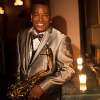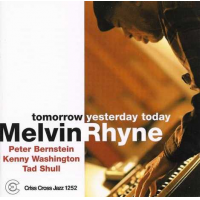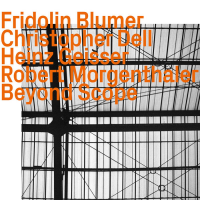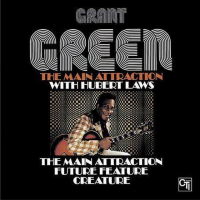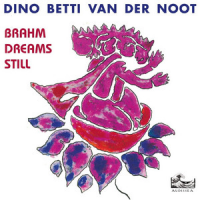Home » Jazz Articles » Liner Notes » Organ Monk: Uwo In the Black
Organ Monk: Uwo In the Black
Lewis coaxes sounds on the C 3 (same electronics as the B 3, but a lighter cabinet) that are well beyond the bluesy basics for swinging soul-jazz established half a century ago by Jimmy Smith, et al. While retaining Monk's sturdy song structures, he plunges into the fusion, funk and new music frontiers opened by Larry Young with Tony Williams' Lifetime, Don Pullen during his Mingus side-gigs in Harlem, Roger Smith with Tower of Power, Chester Thompson of Santana and the like. The result is a success, along the lines of the mandate poet Ezra Pound thrust upon all fellow modernists: "Make it new."
Lewis has the background favorable to doing that. His father, in and out of his childhood home and deceased by the time Greg was 11, had played piano, and in emulation the boy, youngest of three sons, pounded at the keys. Greg grew up attending a variety of black churches, where he was exposed to the organ's evocative dramatics—he plays professionally to this day, at Cavalry A.M.E. Church, Glen Cove. After Greg's father's death, his mother had him take piano lessons in their neighborhood. Greg stuck at it, eventually entering the New School Jazz program and studying with such masters as Gil Coggins and Jaki Byard. Besides Monk, Lewis grew to love the pianism of Elmo Hope and Herbie Nichols—two-handed composer-performers who expanded originality on jazz traditions with bold, usually keeping in sight of the fact that jazz is created in and for serious fun.
Organ Monk: Uwo In the Black offers plenty of fun, as well as being fit for the utmost serious sort of listening. Lewis' second album to be released of three he's planned, it showcases and re-energizes repertoire which has attracted, challenged and enlightened musicians and listeners alike at least since Dizzy Gillespie's Big Band issued its recording of Monk's "'Round Midnight" in 1944. The world still awaits Greg Lewis' "Midnight," but in the excellent company of tenor saxophonist Reggie Woods, guitarist Ron Jackson and drummer Nasheet Waits, the organist on Uwo serves up refreshingly original interpretations of 11 other of Monk's legendary, evergreen though sometimes obscure, catchy and quirky tunes, plus four of his own compositions, conceived with Monk in mind.
Uwo starts with the ultra-reedy sustained squawk and splash of "Little Rootie Tootie," a song Monk penned for his two-year-old son Thelonious Sphere Jr., aka "Tootie" or T.S., who has grown up to chair the activist Thelonious Monk Foundation. Lewis revives "Humph," which Monk recorded only once, during his first session as a leader in 1947; "Skippy," named for Monk's sister, another tune he recorded once, in '52; "Ugly Beauty," Monk's declaration of an esthetic principle and his only waltz, premiered in 1967; "Thelonious," his self-portrait, from '47; "Teo," for Teo Macero, the Columbia Records producer he shared with Miles Davis; the bluesy "Stuffy Turkey," referring to Coleman Hawkins' "Stuffy"; bouncy "Bright Mississippi," which Monk derived from the chord progression of "Sweet Georgia Brown"; the indelible "Crepescule for Nellie," Monk's profound dedication to his wife, and "52nd Street Theme," which Monk had copyrighted in 1944, which was playing nightly by many bands along New York City's post-World War II jazz club stroll, yet which the composer himself never recorded.
Lewis's compositions are seamlessly integrated within the sequence of Monk songs, and are significant occasions in themselves. "My Nephew," which evolves gradually from a hush to a roar, is a rumination about unrealized expectations which do eventually came to pass. "GCP" is a ditty Lewis associated with the Grand Central Parkway he's ridden on since childhood—he was raised in the Queensbridge housing projects of Long Island City, Queens, New York—and was driving daily to work back when it occurred to him. "Why Not" may have a shrug for a title, but as Lewis performs it here he revels in tight embrace of its complicated line and switchbacks. "Zion's Walk" is Lewis' version on his five-year-old son's steppin' style.
The thick textures Lewis gets from his instrument of grit, throb and overdrive are evident in the first notes of "Little Rootie Tootie"; the old school tenor feel Reggie Woods summons, the loose, goosey and emphatic-as-appropriate accents Nashiet Waits employs and the smart, crisp guitar figures Ron Jackson picks follow soon after. "Rootie Tootie," "My Nephew" and "Bright Mississippi" are efforts of the whole quartet; "Humph" "Ugly Beauty," "Stuffy Turkey" and "Teo" feature Lewis with Woods and Waits; "Skippy," "GCP" and "52nd St. Theme" (so-called by critic Leonard Feather; Monk had titled it "Nameless") feature Lewis with Jackson and Waits. "Zion's Walk," "Thelonious" "Why Not" and "Crepescule" show off the rapport between Lewis and Waits, who have known each other, jammed and worked together for more than 20 years.
"I never had lessons on organ," Lewis says. "I just watched other organ players, and learned how the organ lends itself to making the music different each time. You know, you never pull the draws out exactly the same way twice. I might have a set patch for certain sounds, but then in when I'm playing I'll hear something else, and go for it—so it's never really the same."
That's a truism Thelonious Monk subscribed to, and anyone who listens to Uwo: In The Black will be presented with persuasive evidence that even the recorded experience of this music changes. These organ timbres are too rich to seem static, just as Monk's melodies, specific though they are, involve too many paradoxes and conundrums, too much sleight-of-hand magic, for their possibilities to ever be exhausted. Greg Lewis has discovered how to make his organ beam, rasp, bead, growl, sizzle, howl, steam and soar, just as Thelonious Monk understood how to make music he along could heard seem like something anyone could whistle. Put Lewis and Monk together, and get Organ Monk: Uwo (which means "one") In The Black (which might mean any of the several alternatives we can think of), an album at the crossroads, where many things musical might happen and what does can be taken different ways. Only a devotee such as Greg Lewis is could be behind this. His counterintuive—inspired? mad?—idea that Monk and organ go is not wrong, it's right.
Liner Notes copyright © 2026 Howard Mandel.
Uwo in the Black can be purchased here.
Contact Howard Mandel at All About Jazz.
Howard is a Chicago-born writer, editor, author, arts reporter for National Public Radio, consultant and videographer. Visit Howard at howardmandel.com.
Track Listing
Little Rootie Tootie; In The Black – My Nephew; Humph; Skippy; Ugly Beauty; Zion's Walk; GCP; Stuffy Turkey; Bright Mississippi; Thelonious; Why Not; Crepuscule With Nellie; Teo; 52nd Street Theme.
Personnel
Album information
Title: Uwo in the Black | Year Released: 2012 | Record Label: Self Produced
Tags
PREVIOUS / NEXT
Support All About Jazz
 All About Jazz has been a pillar of jazz since 1995, championing it as an art form and, more importantly, supporting the musicians who make it. Our enduring commitment has made "AAJ" one of the most culturally important websites of its kind, read by hundreds of thousands of fans, musicians and industry figures every month.
All About Jazz has been a pillar of jazz since 1995, championing it as an art form and, more importantly, supporting the musicians who make it. Our enduring commitment has made "AAJ" one of the most culturally important websites of its kind, read by hundreds of thousands of fans, musicians and industry figures every month.





